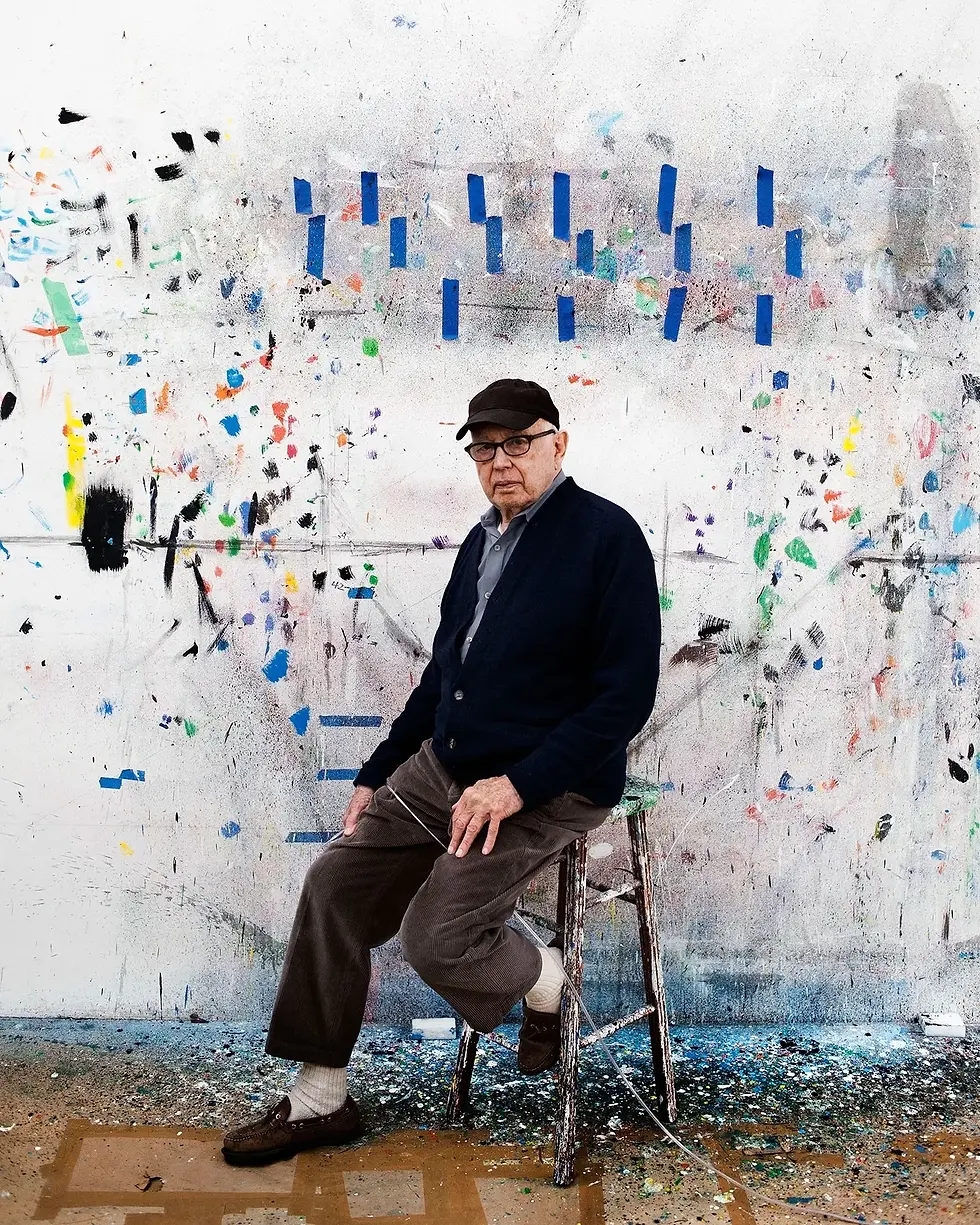Ellsworth Kelly: A Vibrant Journey through Abstract Art
- ONOTABI Editorial Team

- 19 nov 2024
- 3 minuten om te lezen
Bijgewerkt op: 24 dec 2024
Ellsworth Kelly (1923–2015) stands as a seminal figure in 20th-century art, renowned for his contributions to abstraction and minimalism. His oeuvre, characterized by bold colors, geometric forms, and a profound sensitivity to the natural world, has left an indelible mark on modern art. This essay delves into Kelly's artistic evolution, examining his early influences, key works, and enduring legacy.

Photo: Alex Majoli and Daria Birang
Early Life and Education
Born on May 31, 1923, in Newburgh, New York, Ellsworth Kelly was raised in a family that encouraged his artistic inclinations. His early interest in ornithology, particularly bird watching, fostered a keen observational skill that would later inform his artistic practice. In 1941, Kelly enrolled at the Pratt Institute in Brooklyn, where he studied technical art and design. His education was interrupted by World War II; he served in the U.S. Army's 603rd Engineers Camouflage Battalion, a unit tasked with creating deceptive visual strategies to mislead enemy forces. This experience honed his understanding of visual perception and the power of illusion.
After the war, Kelly utilized the G.I. Bill to study at the School of the Museum of Fine Arts in Boston. In 1948, he moved to Paris, enrolling at the École nationale supérieure des Beaux-Arts. During his six-year stay in France, Kelly immersed himself in European modernism, drawing inspiration from artists such as Henri Matisse, Jean Arp, and Constantin Brâncuși. His exposure to Romanesque art, Byzantine mosaics, and the works of the Surrealists further enriched his visual vocabulary.
Artistic Evolution
Kelly's time in Paris was transformative. He began to distance himself from traditional figuration, exploring abstraction through various mediums, including painting, drawing, and collage. His 1949 work, Window, Museum of Modern Art, Paris, exemplifies this shift. The piece, a black and white grid, reflects his interest in architectural forms and the interplay of light and shadow. This period also saw Kelly experimenting with chance operations, influenced by the Dadaists, leading to works like Colors for a Large Wall (1951), a collage of 64 colored panels arranged randomly.
Upon returning to the United States in 1954, Kelly settled in New York City. The American art scene was then dominated by Abstract Expressionism, characterized by gestural brushwork and emotional intensity. In contrast, Kelly's work was marked by clarity, precision, and restraint. His paintings from this era, such as Broadway (1958), feature bold, monochromatic shapes that emphasize form and color over expressive content. This approach aligned him with the emerging Minimalist movement, though Kelly maintained a unique position, often resisting strict categorization.
Key Works and Contributions
Throughout his career, Kelly produced a body of work that consistently explored the relationships between color, form, and space. His Spectrum series, initiated in the 1960s, showcases his mastery of color. In these works, Kelly arranges panels of pure color in sequences that explore chromatic interactions and perceptual effects. Spectrum V (1969), for instance, consists of thirteen panels, each a different color, creating a vibrant visual rhythm.
Kelly's exploration of form is evident in his shaped canvases. Rejecting the traditional rectangular format, he created works like Green White (1961), where the canvas itself assumes a geometric shape, blurring the line between painting and sculpture. This innovation challenged conventional notions of pictorial space and influenced subsequent generations of artists.
In addition to painting, Kelly was an accomplished sculptor. His freestanding works, such as Curve XXII (1981), often mirror the simplicity and elegance of his paintings. These sculptures, typically made of steel or aluminum, engage with their surroundings, casting shadows and interacting with light in ways that enhance their formal qualities.
Kelly's contributions to public art are also noteworthy. His Austin project, completed posthumously in 2018, is a freestanding building on the campus of the Blanton Museum of Art in Texas. Designed as a space for contemplation, it features colored glass windows, a totemic wood sculpture, and black and white marble panels, encapsulating Kelly's lifelong engagement with color, form, and light.
Legacy and Influence
Ellsworth Kelly's impact on modern art is profound. His commitment to abstraction, exploration of color relationships, and innovative use of form have inspired countless artists. His works are held in major museums worldwide, including the Museum of Modern Art in New York, the Tate Modern in London, and the Centre Pompidou in Paris. Exhibitions such as "Ellsworth Kelly: A Centennial Celebration" at MoMA in 2023 have further cemented his status as a pivotal figure in art history.
In conclusion, Ellsworth Kelly's artistic journey reflects a relentless pursuit of purity in form and color. His ability to distill visual experiences into abstract compositions has left an enduring legacy, challenging and expanding the boundaries of modern art.
For those interested in learning more about this fascinating artist, I recommend the following books:
Ellsworth Kelly: A Retrospective by Diane Waldman
Ellsworth Kelly: The Years in France, 1948-1954 by Yve-Alain Bois
Ellsworth Kelly: Plant Drawings by Michael Semff



Opmerkingen